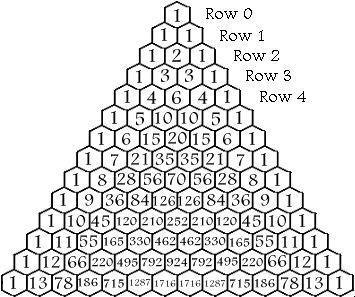I am trying to solve two problems using Pascal's triangle but can't figure them out. Any help would be appreciated.
1. Starting with the second row from the top of Pascal's triangle, what is the sequence of the diagonal (1 2 3 4 5 6 7 )?
2. The sum of each row represents 2n , starting with the first row, which is 20=1. Write an exponential expression for the sum of the values in the sixth row. Simplify the expression. (the sixth row shows (1 5 10 10 5 1 ) ).
Thanks
1. Starting with the second row from the top of Pascal's triangle, what is the sequence of the diagonal (1 2 3 4 5 6 7 )?
2. The sum of each row represents 2n , starting with the first row, which is 20=1. Write an exponential expression for the sum of the values in the sixth row. Simplify the expression. (the sixth row shows (1 5 10 10 5 1 ) ).
Thanks

